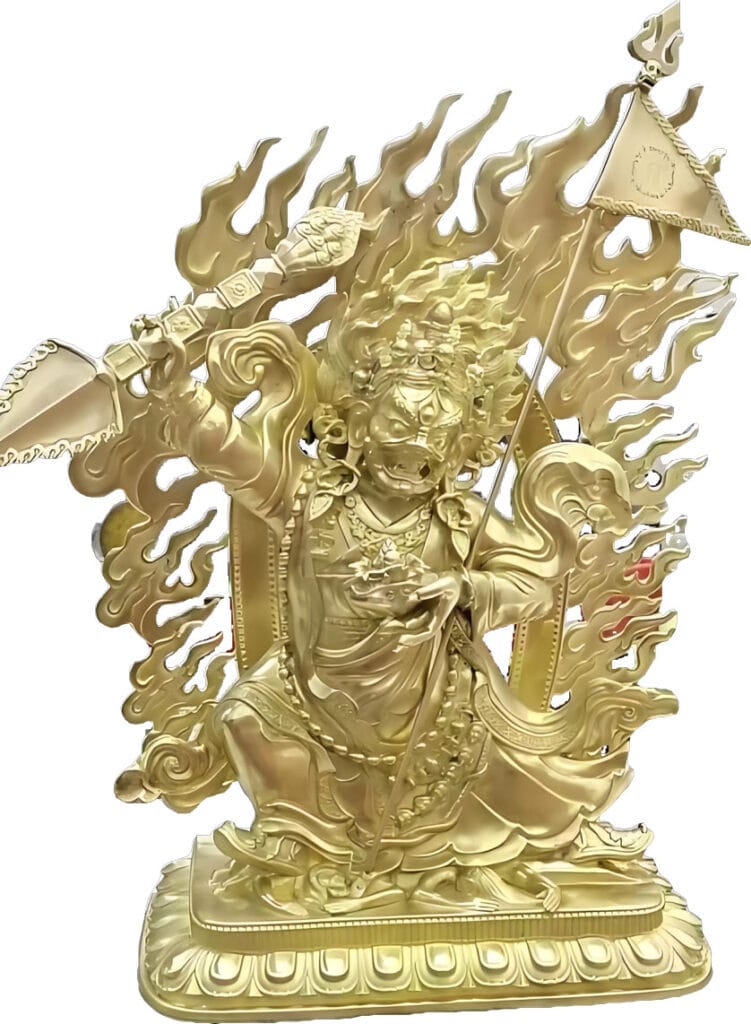
Mahakala

Mahakala is a very important Dharma protector in Buddhism. It is often mentioned in the Vajrayana tantras that the main deity appears as a Dharma protector. There are many forms of Mahakala, which can be basically divided into two categories: the transcendental form of Buddhas and Bodhisattvas and the mundane form of Dharma protectors and their followers.
Mahakala, the Lord of the Assembly, is a protector who transcends the world. His Tibetan name is Ganpo Tsog dag. “Gongpo” means protector, “Tsog” means the harmony of many causes, aspects and forces, and “Da” means the lord. The whole meaning is the Lord of the Assembly.
The Ganesha God of Wealth is also commonly known as the Lord of All Assembly, which means that the body of a human and the head of an elephant are combined into one, and the soul of the god is combined into the body of an animal. It is similar to Mahakala but different.
This Lord of the Assembly, Mahakala, is the manifestation of the unity of wisdom of Samantabhadra Tathagata, Vairocana Tathagata, Avalokitesvara Bodhisattva, Manjushri Bodhisattva, Mahasthamaprapta Bodhisattva, etc. He is the sum of the power of the three great gods, the eight divisions of heavenly beings and dragons, and the ten direction protectors. In terms of appearance, he is respected and worshipped by the sacred objects, ritual instruments, and decorations of each god, which are gathered in one body. In terms of nature, he is an assembly of powers, and in terms of Dharma appearance, he is an assembly of sacred objects. He is revered as the master by the ten direction eight divisions and seventy-five protectors, etc., so he is called the Lord of the Assembly.
The merits and benefits of practicing this method are inconceivable: because it is the incarnation of Vairocana Tathagata, it can eliminate sins and obstacles very quickly; because it is the incarnation of the three Bodhisattvas, it can increase compassion, wisdom and magical powers; because it possesses the power of the three realms and other great gods, the gods of heaven, dragons and earth can only protect but not harm; because the power of the ten directions’ protectors is combined, the blessings, wealth, longevity and wisdom that people desire will increase, and they will have many descendants; because the power of the seventy-five protectors is gathered together, one will not be afraid of enemy invasion and will become noble.
This method comes from the [Continuation of the Fierce Mantras and Sharp Blades], [Continuation of the Fierce Curses and Swearing], [Continuation of the Stacked Divine Rods], etc. It contains various tasks such as eliminating obstacles on the path, summoning the three realms, increasing wealth, and killing enemies. There are three volumes of common and uncommon methods.
The origin of the far-reaching Dharma was that Guru Padmasambhava and two great masters, Danasangdri of India, passed it on to the translation master Vairocana → Yuzha Ningbo and Dili Chokyi Drakpa. The two great masters spread it widely in the eastern Tibet area at that time and the Tibetan areas of Sichuan, Gansu, Qinghai, Yunnan and other places today. It has become a Dharma practiced in all temples regardless of sects.
The recent transmission of hidden treasures was unearthed from Qiubuduodian, Zhongri Sacred Mountain in Seda County today. It contains many mantras. Nowadays, the rituals generally practiced are a combination of the recent and distant transmissions.
The first method that was transmitted to eastern Tibet was the wrathful deity of Avalokitesvara, namely this Mahakala, the Lord of the Assembly. It is also known as the Mahakala, the Lord of the Assembly, method that was transmitted from Kham. Many large Gelugpa monasteries in Sichuan, such as Gedek Monastery, Anqu Monastery, and Rijia Monastery, practice it regularly every year. The Sai Monastery, Zhuoge Monastery, and Rangtang Monastery of the Jonangpa, the Genqin Monastery and Duokuo Monastery of Sakya Derge, and the Gaden and Baiyu Monasteries of the Nyingma Sect attach great importance to it and practice it as one of the main Dharma protectors. All families with historical backgrounds in Kham will especially worship this Dharma protector.